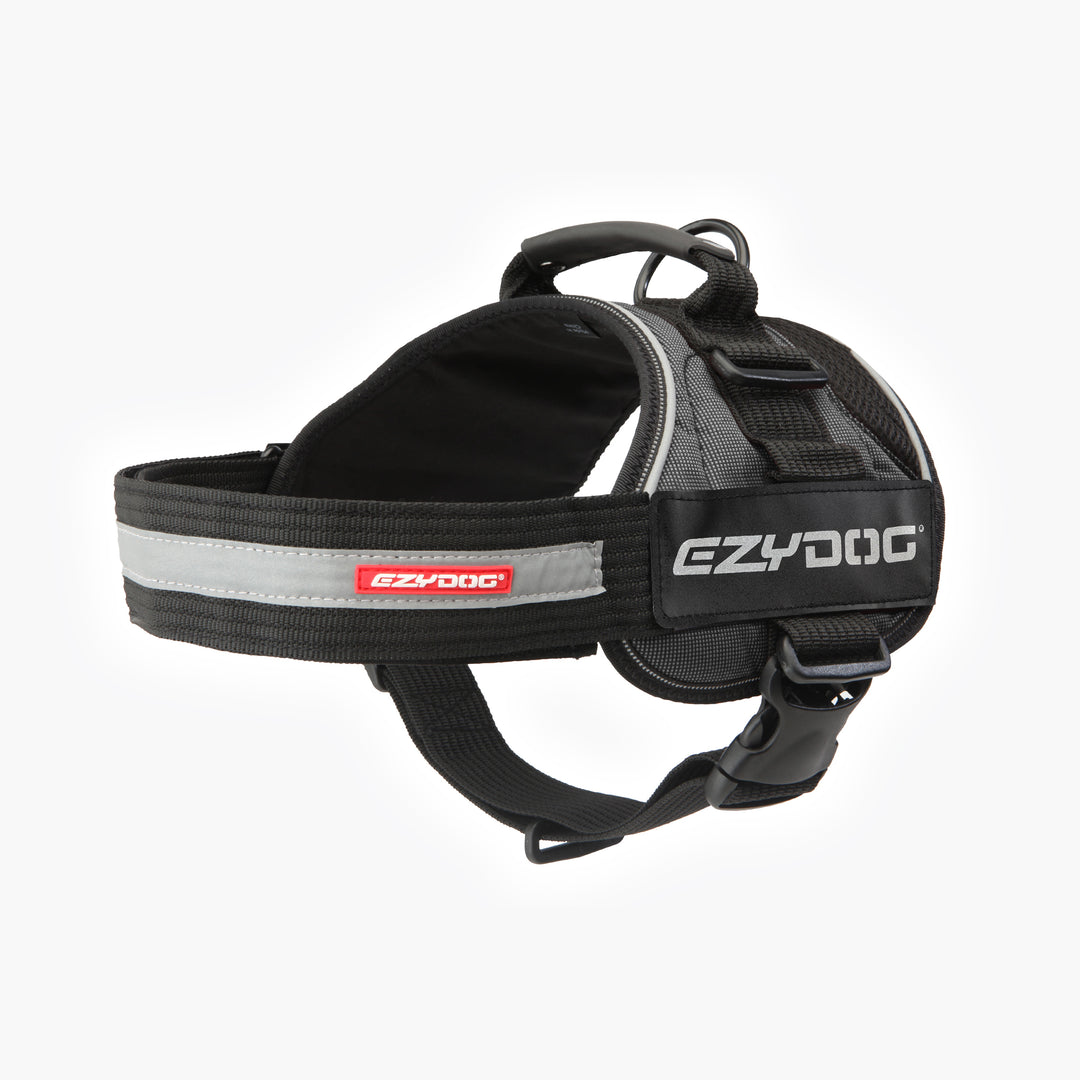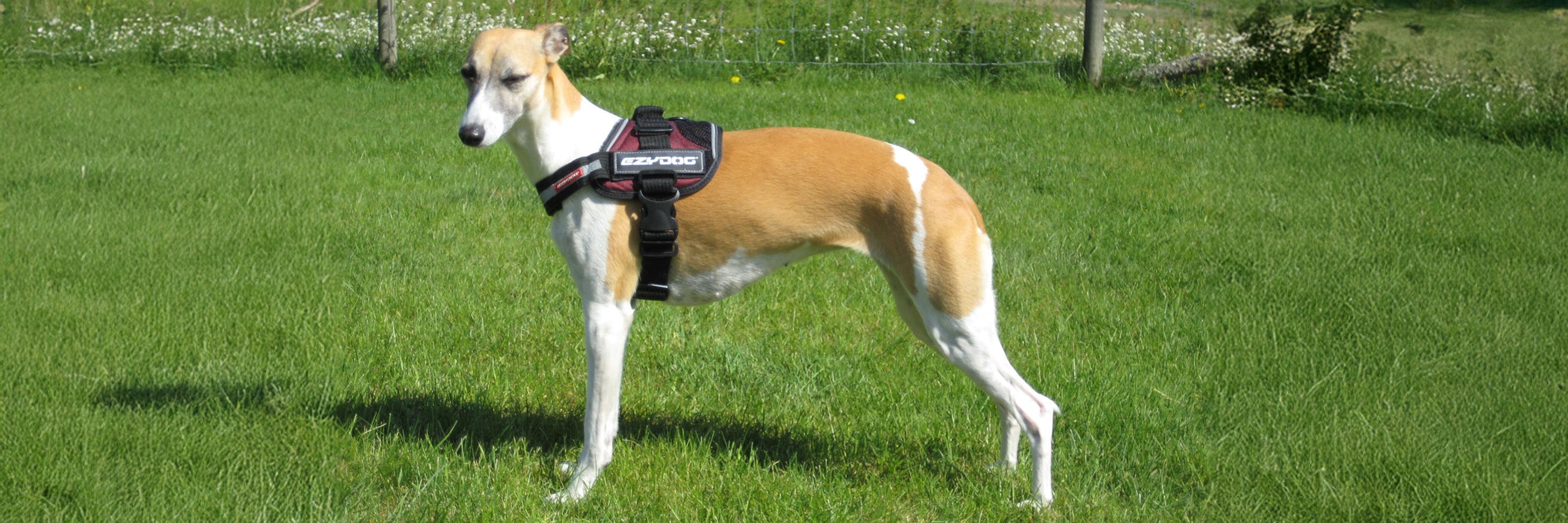German Shepherds are intelligent, athletic dogs with a bold stride and a powerful build. Their deep chests, broad shoulders and thick necks mean they can pull like a freight train when excited.
Many owners discover that standard harnesses slide, rub or even break under the strain of a determined Shepherd. Collars aren’t ideal either – heavy pressure on the neck can harm the trachea and cervical spine.
In this guide we explain why a purpose‑designed harness is essential, what features to look for and how EzyDog’s harness collection keeps your German Shepherd comfortable, secure and stylish.
Harnesses distribute pressure over the chest and shoulders rather than the delicate neck. Research shows that for dogs who pull, non‑tightening front‑clip harnesses offer a good balance between comfort and reducing pulling. Conversely, aversive collars such as choke, prong or electric collars should be avoided.
Understanding the German Shepherd Body & Fit Challenges
German Shepherds are built for strength and endurance: a powerful chest, long back and flexible neck allow them to lunge forward with ease. These traits create a few challenges when choosing a harness:
- Deep chest & broad shoulders: Wide, muscular chests require a harness that allows full range of motion without crossing over the shoulders or restricting gait. A Y‑shaped or chest‑plate design distributes pressure evenly.
- Thick neck & high drive: Traditional collars can compress the trachea and cervical spine, especially when a dog pulls. A harness that sits lower on the chest protects the neck.
- Escape artists: Some Shepherds quickly learn to back out of poorly fitting harnesses. A third belly strap or extended body length helps prevent escape while leaving shoulders free to move.
- Sensitive skin & heavy coat: Coarse nylon or badly placed straps can rub through the undercoat. Soft, padded materials and rounded hardware minimise chafing.
What to Look for in the Best German Shepherd Harness
When evaluating harnesses for your Shepherd, prioritise the following features. These criteria are based on published research, professional training advice and feedback from experienced owners:
- Durable materials & hardware: Opt for heavy‑duty webbing with reinforced stitching and steel or forged‑metal D‑rings. A wide strap distributes pressure more evenly than a narrow cord, reducing the risk of injury.
- Y‑shaped or chest‑plate front: A Y‑shape (sometimes called a non‑restrictive harness) runs down the chest and between the front legs. This design allows natural shoulder movement and protects the trachea.
- Three‑strap (escape‑proof) design: A third belly strap or longer body length behind the rib cage prevents your dog from backing out. Shepherd owners report that dogs can slip out of two‑strap harnesses when startled; an extra strap keeps them contained.
- Multiple adjustment points: Look for at least five areas to fine‑tune fit around the chest, shoulders and belly. Proper fit reduces rubbing and prevents slipping.
- Padded or fleece lining: Soft lining protects the skin under a thick coat. Avoid stiff nylon straps without padding.
- Front and back attachment points: Dual clips let you attach the leash at the chest for training or at the back for relaxed walks. A front clip helps redirect pulling, while a back clip offers stability.
- Grab handle: A sturdy handle along the spine lets you quickly control or assist your dog over obstacles. Choose one that runs with the spine rather than across it to avoid pressure points.
- Reflective accents: High‑visibility trims keep you and your dog safe during early morning or evening walks.
EzyDog Harness Collection for German Shepherds
Our harnesses are engineered with German Shepherds in mind, combining rugged materials with escape‑proof designs and all‑day comfort. Each model below uses premium webbing, steel hardware and thoughtful padding to keep your dog secure and comfortable.

Essential Chest Plate Harness
Our rugged chest‑plate harness moulds to your German Shepherd’s chest for a secure, customised fit. Wide, padded straps distribute weight evenly and a third belly strap prevents escape – perfect for strong pullers.

Quick Fit Harness
This harness slips on easily with a single buckle – ideal for busy mornings. The Y‑shaped front keeps your dog’s shoulders free, while the adjustable girth strap ensures a snug fit for deep‑chested Shepherds.

Convert Dog Harness
A tough yet breathable option for long adventures. Perfect for active Shepherds who need extra control and storage for hiking essentials.
Complementary Gear: Collars, Leashes & More
A harness is just one part of a complete walking setup. Pair your dog’s new harness with martingale and leather collars for identification, double‑ended leashes for greater control, and travel safety gear like car harnesses and seat belts. We also offer reflective vests for visibility, clean‑up supplies for adventures and orthopedic beds to give your Shepherd a cosy place to rest.
Tips for Measuring & Fitting a German Shepherd Harness
Proper fit is vital for safety and comfort. Follow these guidelines when measuring and fitting your harness:
- Use a soft measuring tape to record the neck girth (where a collar sits) and the chest girth (widest part of the rib cage, just behind the front legs).
- Some harnesses list a body length measurement; measure from the base of the neck to the base of the tail.
- When adjusting straps, follow the two‑finger rule: you should be able to fit two fingers snugly between each strap and your dog’s body. Too tight can chafe; too loose allows escape.
- Position the belly strap so it sits on the lower rib cage rather than the abdomen. Adjust each point individually and check the fit regularly, especially as your dog matures or gains/loses weight.
- On your first walks, observe how your dog moves in the harness and adjust if there are any areas of rubbing or restriction.
- If your dog is between sizes, choose the larger size for comfort and use the adjustment points to refine the fit.
- For very strong or reactive dogs, attach a double‑ended leash to both the harness and a martingale collar for extra security.
View EzyDog’s Size Guide for detailed measurements and fitting tips.
Insights & Tips: From German Shepherd Owners
- Harnesses are tools, not magic fixes. No harness will stop pulling by itself. Training loose‑leash walking is essential; a front‑clip harness simply gives you leverage.
- Use the right tool for the activity. Many owners use a robust back‑clip harness with a handle for hiking or running – the handle lets you assist your dog over obstacles and support them on steep terrain. For everyday walks near roads, a front‑clip harness provides more control.
- Don’t overtighten. German Shepherd Owners say that over‑tightening straps to prevent escape can make a harness uncomfortable and encourage your dog to fight it. Instead, choose an escape‑proof design and fit it properly using the two‑finger rule.
- Training reduces stress. Dogs that have learned to walk politely on a leash enjoy walks more and are less likely to injure themselves or their handlers.
- Replace worn gear. Strong Shepherds put a lot of strain on their gear. Inspect webbing, buckles and D‑rings regularly and replace any worn or frayed equipment.
Common Mistakes to Avoid
Even experienced owners make mistakes. Avoid these pitfalls to keep your German Shepherd safe and comfortable:
- Using a collar or restrictive two‑strap harness for a high‑drive dog. A collar can compress the trachea and a harness without a belly strap may allow escape.
- Choosing a chest‑strap harness with a horizontal strap across the shoulders. These designs (sometimes called Norwegian harnesses) are classified as restrictive and can impede shoulder movement.
- Guessing the size. Measure girth accurately and consult the size chart. A poorly fitted harness will rub, restrict movement or slip off.
- Leaving the harness on unsupervised. Remove it during rest to prevent matting, tangling or chewing.
- Using aversive devices. Choke, prong and electric collars cause discomfort and are linked to welfare concerns. Choose humane equipment instead.
Frequently Asked Questions
Why do German Shepherds need special harnesses?
Because of their powerful build and deep chest, German Shepherds can easily break or slip out of poorly fitting harnesses. A purpose‑designed harness distributes pressure across the chest and shoulders, includes an extra belly strap to prevent escape and allows full range of motion.
How do I measure my German Shepherd for a harness?
Use a flexible tape to measure the neck girth (where a collar sits) and the chest girth (widest part of the rib cage). Some harnesses also list body length. Choose the size where your measurements fall and use the adjustment points to refine the fit. If in doubt, size up and adjust down.
Can my German Shepherd wear a harness and collar at the same time?
Yes. Many trainers recommend using a double‑ended leash to attach to both the martingale collar and the harness. This dual connection gives you extra control and prevents sudden lunges from causing injury. Use the collar for ID tags and the harness for distributing pressure.
How tight should the harness be?
Follow the two‑finger rule: you should be able to fit two fingers between the harness and your dog’s body. Too loose and your Shepherd may slip out; too tight can cause chafing. Adjust straps so the belly strap sits on the lower rib cage.
What if my German Shepherd still pulls on walks?
Our Essential Chest Plate and Convert Harnesses include front‑clip options that help redirect pulling by turning your dog toward you. Combine the harness with positive‑reinforcement training for best results. Avoid tightening or aversive “no‑pull” devices, which can cause discomfort.
The Bottom Line
Choosing the right harness for your German Shepherd is one of the most important investments you’ll make for their safety and your peace of mind. Due to their muscular build and high drive, these dogs benefit from a Y‑shaped, escape‑proof harness with a third belly strap. Our Essential Chest Plate, Quick Fit and Convert Harnesses offer options for every lifestyle, from relaxed walks to rugged adventures.
Remember to measure accurately, adjust the harness properly and pair it with a martingale collar and double‑ended leash for added control when necessary. With the right gear and training, every walk becomes a joy rather than a battle.






Leave a comment
This site is protected by hCaptcha and the hCaptcha Privacy Policy and Terms of Service apply.